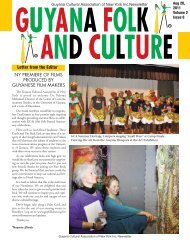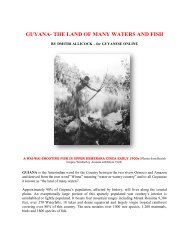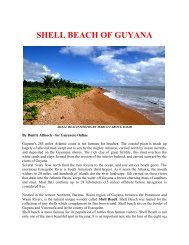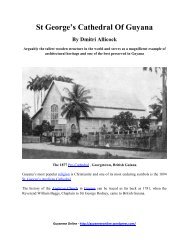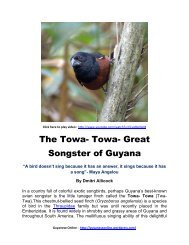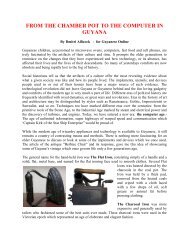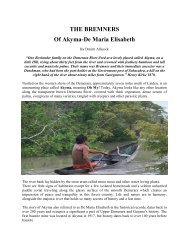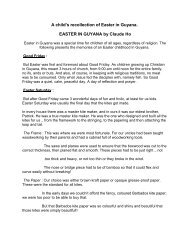Remnants Of The Early Dutch in Guyana 1616 ... - Guyanese Online
Remnants Of The Early Dutch in Guyana 1616 ... - Guyanese Online
Remnants Of The Early Dutch in Guyana 1616 ... - Guyanese Online
Create successful ePaper yourself
Turn your PDF publications into a flip-book with our unique Google optimized e-Paper software.
Fort Nassau on the Berbice River<br />
This is all that rema<strong>in</strong>s of Fort Nassau, on the Berbice River, <strong>Guyana</strong>. Fort Nassau was the<br />
capital of the colony of Berbice. It was situated approximately 88 kilometers upstream the<br />
Berbice River from New Amsterdam.<br />
<strong>The</strong> orig<strong>in</strong>al fort was burnt by the French when they attacked Berbice <strong>in</strong> 1712. A new fort was<br />
subsequently built, which was burned <strong>in</strong> 1763 by Berbice governor Van Hoogenheim to prevent<br />
it from fall<strong>in</strong>g <strong>in</strong> the hands of revolt<strong>in</strong>g slaves.<br />
<strong>The</strong> rema<strong>in</strong>s of Fort Nassau were declared a National Monument by the <strong>Guyanese</strong> government <strong>in</strong><br />
1999. Recently, efforts have been started to preserve the fort.<br />
Only one 18th century description of these build<strong>in</strong>g rema<strong>in</strong>s, from a <strong>Dutch</strong> traveler called<br />
Harts<strong>in</strong>ck. In "Beschrijv<strong>in</strong>g van Guiana of de Wilde Kust", he’d described a structure 100 feet<br />
long and 50 feet wide, which had served as a church, a storehouse, the government, and the<br />
home of the ‘corp de guarde’.<br />
On 8 March 1763, the <strong>Dutch</strong> - faced by a massive slave revolt - spiked the guns, and the fort was<br />
set on fire. Now all that rema<strong>in</strong>s are a few outl<strong>in</strong>es (the hall, and some stables, accord<strong>in</strong>g to<br />
Harts<strong>in</strong>ck, two smithies and some barracks). But, <strong>in</strong>side the forest, it's cathedral-cool, and, on the<br />
day I visited, we also found the old ramparts, a small brick bridge, some glazed tiles, and a stash<br />
of hand-blown bottles.<br />
In 1733, a village which had sprung up around Fort Nassau was named New Amsterdam (<strong>Dutch</strong>:<br />
Nieuw Amsterdam). <strong>The</strong> fort and the village were abandoned <strong>in</strong> 1785 <strong>in</strong> favor of Fort S<strong>in</strong>t<br />
Andries, situated more downstream, at the confluence of the Canje River. <strong>The</strong> new village was<br />
aga<strong>in</strong> named New Amsterdam, and is still known by that name <strong>in</strong> contemporary <strong>Guyana</strong>.



